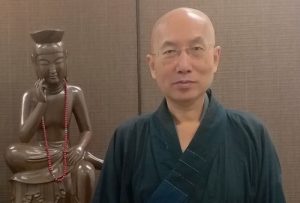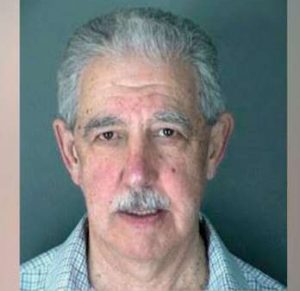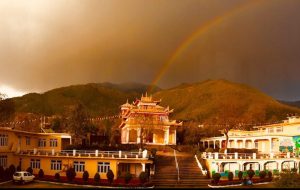
The esteemed Tibetan Buddhist teacher and Dzogchen adept Chökyi Nyima Rinpoche marked the festival celebrating the Buddha’s return to the human realm after entering Tushita by leading the formal inauguration of Pal Thubten Shedrub Ling (also known as Thousand Buddha Temple), in Lumbini, Nepal, the birthplace of the Buddha, in an extensive consecration program running from 19–23 November.
The new shedra, which is affiliated with the growing global mandala of Rinpoche’s Dharma activities, has been founded to support a monastic community at the site of the Buddha’s birth and to extend a welcome to the hundreds of thousands of international pilgrims who visit the sacred site annually.

The full program began on 19 November, with three days of offerings and consecration pujas leading up to Lhabab Duchen on 22 November. The main event featured a final cleaning and consecration pujas, Shakyamuni Buddha sadhana, and prayers to Shakyamuni Buddha and the 16 arhats. On 23 November, Rinpoche led a Thousand Buddhas Empowerment followed by a teaching.
Lhabab Duchen is one of the four most important Buddhist festivals in the Tibetan lunar calendar, falling on the 22nd day of the ninth lunar month. The festival celebrates Shakyamuni Buddha’s return to Earth after teaching in Indra’s realm, known in Sanskrit as Tushita, where, according to tradition, he taught the Dharma for three months.
The temple’s expansive main shrine hall houses magnificent 4.8-meter statues of the Buddhas of the three times, Dipamkara Buddha (past), Shakyamuni Buddha (present) and Maitreya Buddha (future), encompassed by 1,000 46-centimeter Buddha statues—all cast in copper and gilded in gold.

According to Chokyi Nyima Rinpoche, just seeing these images has the power to relieve one’s mind of worry and to dispel needless thoughts, bringing one to a state of peace and delight.
“[My teacher] Kunu Lama [Tenzin Gyaltsen] said a few words to me about the necessity of constructing statues of Shakyamuni Buddha that have remained important to me,” Chokyi Nyima Rinpoche explained in a text shared with BDG. “He said that if we build excellent statues of Shakyamuni Buddha out of valuable materials, adorned with the 32 major and 80 minor marks perfectly complete, and make many of them, and large ones, and if these are installed as the central image in a temple, or used as the central support for one’s own practice, if one makes prostrations, offerings, and shows respect to such statues, and practices meditation in front of them, this will be an auspicious coincidence that will allow for the teachings of the Buddha Shakyamuni to remain for a long time in our world. . . .
“At Rumtek Gompa when I was around 18 or 19 years old, the Karmapa Rangjung Rikpe Dorje said: ‘For the Buddha’s teaching to remain in the world for a long time, we have to build statues of the Buddha. It’s absolutely necessary to build a thousand Buddha statues. And we did make those statues, right? This is an auspicious sign that the Buddha’s teachings will remain in the world for many thousands of years.”
Rinpoche presided over the two-day inauguration and opening ceremony for Pal Thubten Shedrub Ling, on 22–23 November, in the presence of Yongey Mingyur Rinpoche, Tsoknyi Rinpoche, Phakchok Rinpoche, Orgyen Tobgyal Rinpoche, as well as staff, students, and alumni of Rinpoche’s Rangjung Yeshe Institute in Kathmandu, along with a host of devotees and well-wishers from all over the world.
“In Pal Thubten Shedrub Ling, we are surrounded by a thousand Buddha images,” Chokyi Nyima Rinpoche observed. “If we perform a single prostration, it is equivalent to prostrating before a thousand Buddhas all at once. Even offering a single light or flower carries the merit of offering to a thousand Buddhas. This is why the Thousand Buddha Temple is a profoundly important support for Dharma practitioners. It is a place that anyone can visit, pray, and accumulate great merit with little hardship. I believe that if we all rejoice in the creation of this temple, truly vast merit will be gathered. As the saying goes, ‘Accumulating great merit helps cultivate great wisdom.’
“It is with this understanding that I was originally inspired to build a temple that would serve, now and for all future generations, as a sanctuary for Buddhist practitioners of all traditions. I sincerely wanted to open a wellspring of joy and peace for all who visit Lumbini—the birthplace of the Buddha, a World Heritage Site that belongs to everyone. My aspiration was for the Thousand Buddha Temple to be an oasis of tranquility that would radiate peace, happiness, and well-being for all sentient beings throughout all worlds.”
Chökyi Nyima Rinpoche is considered to be one of the greatest living masters of the Dzogchen or “Great Perfection” tradition of Vajrayana Buddhism—a gentle yet imposing figure whose presence is one of warmth and compassion. The eldest son of the revered Dzogchen master Kyabje Tulku Urgyen Rinpoche and the devoted practitioner Kunsang Dechen, Chökyi Nyima Rinpoche was born in Tibet in 1951. He was recognized as the seventh incarnation of the Drikung Kagyu lama Gar Drubchen, a Tibetan mahasiddha and an emanation of the second-century Indian Buddhist philosopher Nagarjuna.
Following the invasion of Tibet, Rinpoche spent his youth in India, studying for 11 years under the care of His Holiness the 16th Gyalwang Karmapa at Rumtek Monastery. He also studied and practiced under the venerated masters Dilgo Khyentse Rinpoche, Dudjom Rinpoche, Khunu Lama Tenzin Gyaltsen, as well as his own father, Tulku Urgyen Rinpoche. In 1974, Rinpoche joined his parents in Kathmandu, where he assisted them in establishing Ka-Nying Shedrub Ling, a monastery on the outskirts of the city, just a short walk from the benevolent gaze of the venerable Boudhanath Stupa. Rinpoche became the abbot of Ka-Nying Shedrub Ling in 1976, at the age of just 25, and has since overseen the welfare and spiritual education of many hundreds of male and female monastics.
Ka-Nying Shedrub Ling, a dedicated sanctuary for studying and practicing the Buddhadharma, lies at the heart of Rinpoche’s growing mandala of Dharmic activities. Among his numerous initiatives and projects, Rinpoche, now 72 years old, has authored several books and founded a network of meditation centers around the world. In 1997, Chökyi Nyima Rinpoche established the Rangjung Yeshe Institute within the grounds of Ka-Nying Shedrub Ling. The institute affiliated with Kathmandu University in 2002 to form the Center for Buddhist Studies. Today, the center offers a range of courses at various levels, including BA, MA, and PhD degrees in Buddhist studies and Himalayan languages, with classes held at the monastery’s monastic college.
See more
Chokyi Nyima Rinpoche (Facebook)
Pal Thubten Shedrub Ling Monastery – Thousand Buddha Temple (Facebook)
Rangjung Yeshe Institute
Shedrub
DharmaSun
Related news reports from BDG
Chökyi Nyima Rinpoche Inaugurates New Dharma Center in Lisbon
Special Report: Chökyi Nyima Rinpoche Marks Vesak with First-Phase Consecration of New Monastery in Lumbini
84000 Announces Online Teaching with Chokyi Nyima Rinpoche on 1 August
Live-streamed Concert for Buddhist Monastery and Nunnery in Nepal to Feature Norah Jones, Richard Gere, Laurie Anderson, and More
Related features from BDG
Clearing the Path to Compassion: A Conversation with Chökyi Nyima Rinpoche
Bodhicitta and the Buddhadharma: An Interview with His Holiness the 41st Sakya Trizin
Buddhism in the Hidden Valley, Part 1: An Ancient Heritage in Tsum
Licchavi House, a Refuge for Art, Culture, and the Buddhadharma in Kathmandu













